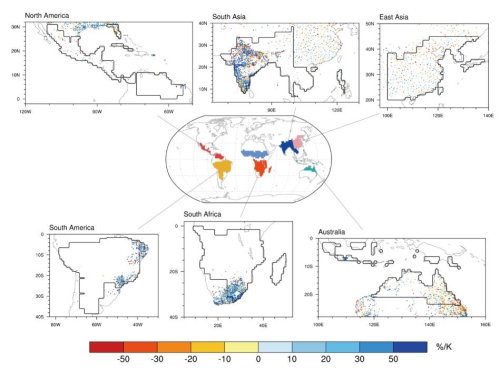
Global warming has already led to significant increases in extreme rainfall over the global land monsoon regions over the past century, according to a study recently published in Journal of Climate.
The research, providing a global perspective of the monsoon regions which sprawl north and south from the Earth’s equator, reveals significant associations between global warming and the observed intensification of extreme rainfall over the global monsoon region and its several subregions, including the southern part of South Africa, India, North America and the eastern part of the South America.
"Extreme rainfall over the global monsoon regions deserves specific attention as it is more intense than that on the rest of the land and affects nearly two-thirds of the world’s population," said Prof. ZHOU Tianjun, the corresponding author on the paper.
ZHOU is a senior scientist at the State Key Laboratory of Numerical Modeling for Atmospheric Sciences and Geophysical Fluid Dynamics at the Institute of Atmospheric Physics and CAS Center for Excellence in Tibetan Plateau Earth Sciences in the Chinese Academy of Sciences. He is also a professor at the University of Chinese Academy of Sciences.
To maximize the data coverage for analysis, scientists combined several sets of long-running, high-quality global and regional extreme precipitation observations currently available. Employing rigorous statistical tests, they demonstrated that the significant influence of global warming on regional extreme rainfall changes is robust regardless of different time periods of analysis, criteria of selecting stations and datasets used.
While identifying an overall increase pattern in extreme rainfall over global monsoon regions as a whole, scientists also noted distinct regional characteristics. "This is because apart from global warming, extreme rainfall is also affected by regional processes such as aerosols, urbanization, and climate natural variability (i.e., the variability intrinsic to climate system)," said Prof. ZHOU. "These effects are important especially at regional scales, such as for the East Asian and Australian monsoon regions."

Response of annual maximum daily precipitation to global mean near-surface air temperature changes over 1901-2010 from the merged observational datasets over monsoon subregions (unit: percent change per degree of global warming, %/K). The map shows the division of monsoon subregions. Each dot denotes an observing station. Note extreme precipitation changes on station scales are also affected by climate noise apart from global warming. (Image by ZHANG Wenxia)
The researchers will continue to study how different physical processes have affected extreme rainfall in the observations. "There are several challenges in the understanding of extreme rainfall changes, including the limited spatial and temporal coverages of the observations. Further improvement in monitoring and data sharing within the climate research community is required," ZHOU said. "Our result laid a basis for further understanding of human influence on extreme rainfall changes in the monsoon regions."
This work was jointly supported by the National Key Research and Development Program of China, National Natural Science Foundation of China, International Partnership Program of Chinese Academy of Sciences, and China Postdoctoral Science Foundation.

86-10-68597521 (day)
86-10-68597289 (night)

52 Sanlihe Rd., Xicheng District,
Beijing, China (100864)

